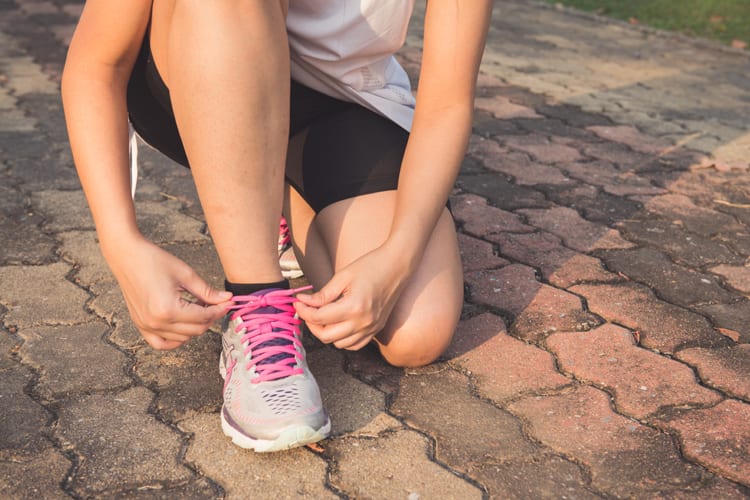Athletic shoes in a sports store aren’t just for show; each pair is designed with a specific purpose. Depending on the sport or activity—be it a marathon, cross-training, or weight-lifting—the type of shoe you wear is crucial for your performance and safety. Each activity has unique demands and risks, while the proper footwear can prevent injuries. This guide, prepared by a trusted running shoe store, will help you understand the importance of good athletic footwear and make the best choice for your feet.

Injury Prevention: Types of Athletic Shoes
Here’s a situation. For some reason, a person chooses to run in training shoes. At the start of the run, the new training shoes look good and feel comfy. But after a few miles, their feet hurt, and the shoes seem heavy. It’s because most training shoes are not designed for running. Yes, you may find workout shoes with running-specific features, like Hoka shoes, the Kawana, for example. These trainers feature an early-stage meta-rocker to promote smooth transition toe-off, but, unlike in their running shoes, the rocker is less aggressive to cover more activities.
So, workout gym shoes usually offer excess support, which makes them stiff and heavier due to extra material, causing fatigue – a runner’s worst enemy. Running shoes, on the other hand, are made more lightweight than generic training shoes and specifically for heel-to-toe movement, with a flexible front part to aid in pushing off. They are meant to cushion your feet from impact and help move you forward.
Now, if you choose running shoes for a tennis court, you might slip or roll your ankle due to a lack of support for lateral movement, as running shoes are designed for forward movement. If you engage in tennis, basketball, HIIT workouts, or other activities that require side-to-side motion, tennis and cross-training shoes featuring a wider base are ideal.
For weight-lifting, you also need separate lifting shoes. Classic weight-lifting shoes have raised heels to help keep correct form and provide stability for all movements. Flat-sole shoes are also used for lifting, but squatting without stretched ankles in these could be challenging.
So, what we’re trying to say is that not only do you feel more comfortable in athletic shoes made for your sport – but they are also designed to prevent sport-specific injuries like ankle rolling in tennis or shin splints in running. So, here’s what you should pay attention to:
- Road Running: Designed with ample cushioning, road running shoes provide excellent shock absorption for running on hard surfaces like pavement or concrete. Minimalist options are also available for those whose bodies are adapted to less cushioning.
- Trail Running: Trail running shoes are built for durability and come with ample traction, ensuring comfortable and safe runs on rugged trails. Since trail running requires more material and design features to protect feet, trail shoes usually are heavier than road shoes.
- Workout: Gym shoes offer lateral control and front flexibility. The best ones are versatile, supporting a range of sports activities in the gym.
- Tennis: Good support tennis shoes provide support for quick side-to-side movements and weight shifts.
- Weight-lifting: For deadlifts, weight-lifting shoes with an elevated heel are essential. For less intense lifts, a minimalist flat-sole design can also do. Don’t use cushioned shoes for weightlifting.
- Basketball: Offering ample stability and support, basketball shoes feature a thick, stiff sole. High-top designs can further help prevent ankle rolling.
- Sneakers vs. Athletic Shoes: Sneakers, often designed as non-athletic shoes with fashion and casual wear in mind, can be used for light sports activities but may lack the specialized features found in athletic shoes.
Cushioning: Stack Height & Heel Drop
When choosing athletic shoes, pay attention to stack height and heel-to-toe drop, as these two are related to the amount of cushioning and, hence, the level of shock absorption.
Stack height in shoes denotes the material thickness between your foot and the ground. High stack height offers more cushioning, ideal for long-distance running or hard surfaces. Low stack height provides less cushioning but a more responsive feel, favored by competitive runners for quicker feedback and propulsion.
Heel drop, or offset, is the heel-to-forefoot height difference. High heel drop (10-12 mm) supports heel-strike runners and eases Achilles tendon strain. Low or zero heel drop (0-6 mm) fosters a natural gait with mid or forefoot strike, potentially reducing injuries like the runner’s knee. Note that if you want to shift to lower-drop shoes, do it gradually, as this transition usually increases the load on the calf muscles and Achilles tendon.
Supportive Athletic Shoes & Pronation Type
Pronation, the inward roll of your foot upon landing, is unique to each athlete. This rotation in the ankle joint varies as neutral, overpronation (too much inward roll), or supination (insufficient roll). Pronation type influences how your feet absorb impact and the support needed from athletic shoes.
Athletic shoes are classified into three types:
- Motion control shoes are suitable for severe overpronators or flat-footed athletes due to their rigid heel counter and arch-side reinforcement, providing maximum support and limited side-to-side twists.
- Stability shoes cater to mild to moderate overpronators. They are less rigid than motion-control shoes, with a pliable yet firm midfoot and less pronounced arch material.
- Neutral shoes, flexible and lacking extra arch material, suit neutral runners, mild overpronators, and supinators.
Stability and motion-control shoes manage foot movement, distribute impact evenly, reduce strain, and help prevent destructive conditions.
Benefits of Proper Athletic Shoes
- Injury Prevention: Proper athletic shoes provide cushioning in critical areas and arch support, protecting your feet from joint pain and stress fractures during high-impact sports. They also form a protective barrier against cuts and scrapes. (Think trail running shoes)
- Enhanced Performance: Sport-specific shoes, designed with elements that ensure proper shock absorption, ankle support, balance, and stability, can improve your performance.
- Foot Health Maintenance: Regularly wearing the right athletic shoes and checking your feet for signs of injury (swelling, redness, blisters, calluses) can promote foot health. If you notice consistent foot issues post-exercise, consider updating your footwear.
- Comfort: The right shoes should feel naturally comfortable, cushioning your foot and aiding in foot alignment upon ground contact. Uncomfortable shoes can cause pain and stress to tissues, bones, and joints. Ensure your shoes fit well and provide comfort throughout your activity or exercise routine.
Tip to Choosing the Right Fit for Athletic Shoes
Choosing the right athletic shoes requires understanding your body, biomechanics, and sport. Here are some tips:
- Visit specialty running stores for expert advice.
- Try on shoes when your feet are swollen – after a workout or at the end of the day.
- Wear your sport-specific socks and orthotics while trying shoes.
- Re-lace the shoes and ensure they feel comfortable immediately. Test them in-store: run, walk, or jump. Also, ensure your heel is secure.
- Replace shoes after 300-500 miles of running or 300 hours of exercise because cushioning wears down.




